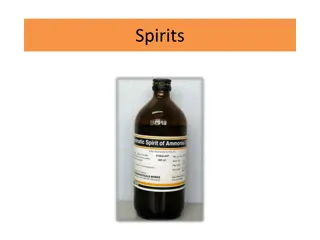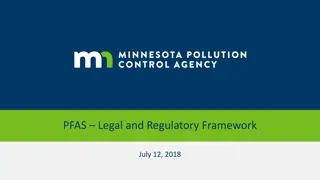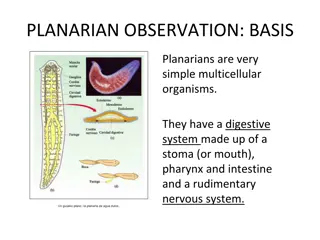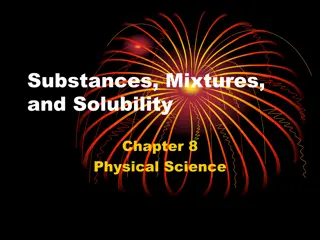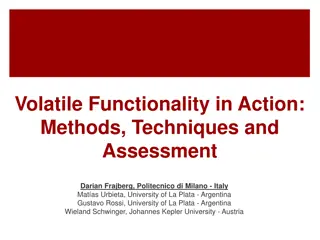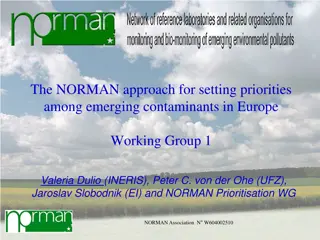Understanding Spirits and Their Uses in Therapeutics and Flavoring
Spirits, also known as essences, are alcoholic or hydro-alcoholic solutions containing volatile substances. They can be classified based on therapeutic or flavoring purposes. These solutions are prepared by distillation or dissolving volatile substances in alcohol, with varying alcohol content. Spir
4 views • 17 slides
Understanding Pharmaceutical Degradation: Types and Factors
Pharmaceutical degradation refers to the process of a formulation in a specific container losing its chemical, microbiological, therapeutic, physical, and toxicological specifications. It can be categorized into physical, chemical, and microbiological degradation. Physical degradation alters the dru
1 views • 50 slides
Understanding Spirits: Types and Uses
Spirits are alcoholic or hydro-alcoholic solutions of volatile principles, mainly volatile oils, classified into therapeutic and flavoring types. They are prepared by distillation or dissolving volatile substances in alcohol, with varying alcohol content. Proper storage in light-resistant containers
1 views • 20 slides
Volatile Oils in Pharmacognosy and Phytochemistry: Composition, Chemistry, Uses
Volatile oils, also known as essential oils, are derived from terpenes and their oxygenated compounds. These oils possess characteristic odors and are extracted from plants through various methods like hydro-distillation and steam distillation. They are commonly used as flavoring agents, perfumes, a
0 views • 29 slides
Understanding Memory Organization in Computers
The memory unit is crucial in any digital computer for storing programs and data. It comprises main memory, auxiliary memory, and cache memory, each serving different roles in data storage and retrieval. Main memory directly communicates with the CPU, while cache memory enhances processing speed by
1 views • 37 slides
Understanding Mixtures and Separation Techniques
Explore the concepts of mixtures and separation, from the definition of dominant and recessive alleles to the advantages of electron microscopes. Learn about identifying pure substances, differences between pure and impure substances, and techniques like filtration and crystallization for separation
1 views • 19 slides
Understanding Movement of Substances Through Cell Membrane
Substances enter and leave cells through diffusion and osmosis processes, driven by concentration gradients. The cell membrane plays a crucial role in selectively allowing substances to pass, ensuring cell survival. Osmosis can be demonstrated using Visking tubing, showing water molecules moving whi
0 views • 15 slides
Understanding Cell Membrane Transport: Diffusion and Facilitated Diffusion
Cell membrane transport plays a crucial role in maintaining cellular functions by regulating the movement of substances across the membrane. Diffusion, a passive transport process, allows molecules to move from areas of high concentration to low concentration without energy expenditure. Within diffu
2 views • 20 slides
Understanding Doping and Anti-Doping Rule Violations
Doping refers to the occurrence of various violations outlined in the World Anti-Doping Code, leading to Anti-Doping Rule Violations (ADRVs). Athletes are accountable for any prohibited substances found in their system, whether consumed knowingly or unknowingly. The list of banned substances is dete
2 views • 6 slides
Understanding New Psychoactive Substances (NPS) and Their Categories
New Psychoactive Substances (NPS) are substances of abuse not regulated by international drug conventions, posing significant public health risks. These substances can fall under categories like synthetic cannabinoids, stimulants, hallucinogens, and depressants, each with unique risks and effects. S
0 views • 11 slides
Distillation Process and Applications in Food Industry
Distillation is a separation process used in the food industry to separate components in a mixture based on their volatility. It involves vaporization, condensation, and re-evaporation to achieve separation. Steam distillation is a method where steam is used to reduce boiling temperatures for safe s
1 views • 13 slides
Distillation: A Method for Separating Volatile Substances
Distillation is a method used in pharmacy to extract active principles, separate substances, and recover solvents. Simple distillation involves vaporizing a liquid, condensing the vapors, and collecting the liquid. It is commonly used for separating liquids from non-volatile solids under atmospheric
1 views • 69 slides
Understanding Antigens and Immunogens: Types and Properties
Antigens are substances that stimulate the production of antibodies in the body, exhibiting specificity in immune reactions. They interact with immune response products like antibodies, BCRs, and TCRs. Immunogens induce detectable immune responses, leading to antibody production or T cell activation
1 views • 30 slides
Understanding Inhalation Anaesthetics in Veterinary Pharmacology & Toxicology
Explore the world of inhalation anaesthetics in veterinary medicine, from the concept of MAC to the classification of gaseous and volatile agents. Learn about blood/gas and oil/gas partition coefficients, along with the properties of popular volatile anaesthetics like Ether, Halothane, and Methoxyfl
1 views • 15 slides
Quantifying Substances in Mixtures Using Gas Chromatography
Gas chromatography is a precise method to quantify substances in mixtures, essential for various applications like food quality analysis, blood alcohol content testing, and developing green energy technologies. By accurately determining the identity and quantity of substances, such as pesticides in
2 views • 29 slides
Understanding Different Types of Memory in MSP430 Microcontrollers
MSP430 memory includes volatile RAM, dynamic RAM, nonvolatile ROM, EPROM, and flash memory. Each type has unique characteristics such as data retention, ease of read/write, cost implications, and methods of programming and erasing. Microcontrollers utilize various memory types based on requirements
0 views • 73 slides
Preparation Methods and Uses of Aromatic Water in Pharmacy
Aromatic water is a liquid pharmaceutical preparation containing volatile oils or essential oils. It is used as a pleasant medium for administering water-soluble drugs. Various preparation methods include distillation, solution, alternate solution, and dilution methods. Distillation method is used f
2 views • 17 slides
Gas Chromatography: Introduction, Theory, Instrumentation, Derivatization
Gas chromatography is a powerful analytical technique used for separating and analyzing volatile compounds. It involves a mobile gas phase passing through a stationary phase, with components in the mixture interacting differently, resulting in separation. The technique dates back to 1905 and has evo
0 views • 12 slides
Optimizing Memory and Storage Support for Non-Volatile Memory Systems - JanusJanus
JanusJanus focuses on optimizing memory and storage support for non-volatile memory systems by parallelizing sub-operations and pre-executing based on dependencies. This approach enhances performance, achieving 2X faster results compared to serialized baselines. The system addresses the critical pat
0 views • 50 slides
Understanding Allergies to Animals and Living Organisms
Allergies to animals and living organisms are a result of specific immune processes triggered by allergenic substances like proteins and peptides. This allergic response can be caused by various animal proteins such as dog allergens Can f.1, Can f.2, and Can f.3, and cat allergen Fel d1. The represe
1 views • 10 slides
Trends in New Psychoactive Substances Seizures and Use
Seizures of both plant-based and synthetic New Psychoactive Substances (NPS) declined in 2018, along with a decrease in global seizures of khat and fluctuations in the use of NPS. Legislation on substances like mephedrone led to a decline in their use, while the use of ketamine increased. NPS use va
0 views • 8 slides
Essential Insights on Volatile Oils and Their Properties in Pharmacognosy
Explore the fascinating world of volatile oils in pharmacognosy with Dr. Nisha Sharma, an Associate Professor at C.S.J.M. University. Learn about the physical and chemical properties of volatile oils, their classification based on functional groups, and examples of different types of volatile oils u
0 views • 12 slides
Pure Substances vs. Mixtures: Characteristics and Differences
Pure substances have a fixed composition and distinct properties, while mixtures vary in composition and properties. Pure substances cannot be separated into simpler substances by physical methods, whereas mixtures can be. This article explores the characteristics, distinctions, and examples of pure
0 views • 13 slides
Overview of PFAS Legal and Regulatory Framework
This document outlines the legal and regulatory framework surrounding PFAS (per- and polyfluoroalkyl substances), including hazardous waste designation, historical context at 3M sites, and the definition of hazardous substances and waste according to Minnesota statutes. It also discusses the potenti
0 views • 19 slides
Understanding the Concept of Volatile Variables in Multithreading
In computer programming, volatile variables play a crucial role in multithreading scenarios. They ensure that changes made by one thread are visible to other threads by bypassing caching mechanisms. This article explores the significance of volatile variables and their use cases in Java and C, shedd
0 views • 17 slides
Planarian Observation: Nervous System Activity Study
Planarian Observation involves studying the effects of different substances on a planarian's nervous system. Through remote laboratory experiments, observations are made on the movement of planarians in various solutions compared to a control solution. Results are analyzed to determine the effects o
0 views • 7 slides
Understanding Substances, Mixtures, and Solubility in Physical Science
Explore the concepts of substances, mixtures, and solubility in Physical Science with a detailed explanation of solutions, types of mixtures, and the importance of understanding these in everyday life. Discover the differences between atoms, elements, pure substances, and mixtures, and learn about h
0 views • 81 slides
Understanding pH Scale and Acidic Substances
Explore the pH scale and identify acidic substances by placing them correctly. Understand the acidity levels of common substances like water, orange juice, stomach acid, baking soda, and drain opener. Test your knowledge with interactive images depicting pH levels.
0 views • 8 slides
Understanding Volatile Oils in Pharmacognosy: Properties, Composition, and Uses
Volatile oils, also known as essential oils, are complex plant products containing volatile principles. They are colorless but may darken over time. Immiscible with water, they have distinct odors and tastes, and are soluble in organic solvents. Officially sourced from plants, volatile oils have the
0 views • 13 slides
Understanding Volatile Oils in Pharmacognosy: Properties, Uses, and Applications
Volatile oils, also known as essential oils, are hydrophobic liquids extracted from plants containing volatile chemical compounds. These oils have diverse physical and chemical properties, making them valuable in various fields like aromatherapy, perfumery, and therapeutics. Learn about the differen
0 views • 12 slides
Understanding Different Types of Memory Technologies in Computer Systems
Explore the realm of memory technologies with an overview of ROM, RAM, non-volatile memories, and programmable memory options. Delve into the intricacies of read-only memory, volatile vs. non-volatile memory, and the various types of memory dimensions. Gain insights into the workings of ROM, includi
0 views • 45 slides
Managing Volatile Functionality in Web Applications
Explore the challenges of incorporating and removing volatile functionalities in web applications post-deployment. Learn about the impact on code quality, performance, and project costs, and discover methods and techniques for efficient management. Case studies like Black Friday promotions illustrat
0 views • 31 slides
Quality Issues in Clinical Trial Materials: CMC Review by Dr. Dorota Matecka
Clinical trial materials undergo Chemistry, Manufacturing, and Controls (CMC) review to ensure pharmaceutical quality. This process includes assessing safety concerns, impurities, and specifications, along with other CMC considerations. Pharmaceutical quality encompasses the suitability, identity, s
0 views • 41 slides
Prioritization of Emerging Contaminants in Europe
The NORMAN approach focuses on setting priorities among emerging contaminants in Europe by selecting over 700 substances based on expert judgment and scientific literature citations. The prioritization scheme specifically designed for emerging substances involves assessing knowledge gaps and necessa
0 views • 17 slides
NCAA Drug Testing and Banned Substances Guidelines
The NCAA annually disseminates a list of banned drug classes and provides drug education to student-athletes, including mid-year transfers. Drug testing programs focus on prevention and safety, with sanctions in place to uphold competitive balance. Testing includes steroids, stimulants, and recreati
0 views • 9 slides
Exothermic and Endothermic Reactions of Different Substances
Learn about the concepts of exothermic and endothermic reactions, featuring specific substances like sodium hydroxide, lithium nitrate, ammonium nitrate, crystalline ammonium nitrate, and potassium bromide. Discover their properties, uses, and how they interact with water. Explore how these reaction
0 views • 5 slides
Understanding Volatile Oils in Pharmacognosy: Properties and Applications
Volatile oils, also known as essential oils, play a crucial role in pharmacognosy due to their complex composition and therapeutic benefits. These oils are immiscible with water but soluble in organic solvents, and their chemical composition includes terpene derivatives and aromatic compounds. They
0 views • 11 slides
Understanding Secondary Organic Aerosol Formation from Volatile Chemical Products
This research explores the impacts of volatile chemical products (VCPs) on secondary organic aerosol (SOA) formation. By identifying chemical tracers, assessing VCP contributions, and analyzing VOC emissions in different cities, the study aims to enhance our understanding of air quality and sources
0 views • 16 slides
Understanding Inhalant Abuse: Risks, Effects, and Prevention
Inhalant abuse is a widespread issue, with volatile substances being inhaled to achieve psychoactive effects. This form of substance abuse poses significant toxicological and social hazards, often affecting marginalized populations such as neglected street children. The accessibility, affordability,
0 views • 44 slides
Chemical Substances Preparation Methods
Methods for preparing chemical substances including calculations for molarity, preparation of solutions from solid and liquid substances, and examples for preparing specific solutions like BaCl2 and CuSO4. Explained techniques for calculating the amount of solid substances needed to achieve a desire
0 views • 8 slides


